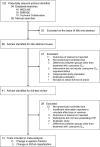Effect of coenzyme Q₁₀ supplementation on heart failure: a meta-analysis
- PMID: 23221577
- PMCID: PMC3742297
- DOI: 10.3945/ajcn.112.040741
Effect of coenzyme Q₁₀ supplementation on heart failure: a meta-analysis
Abstract
Background: Coenzyme Q₁₀ (CoQ₁₀; also called ubiquinone) is an antioxidant that has been postulated to improve functional status in congestive heart failure (CHF). Several randomized controlled trials have examined the effects of CoQ₁₀ on CHF with inconclusive results.
Objective: The objective of this meta-analysis was to evaluate the impact of CoQ₁₀ supplementation on the ejection fraction (EF) and New York Heart Association (NYHA) functional classification in patients with CHF.
Design: A systematic review of the literature was conducted by using databases including MEDLINE, EMBASE, the Cochrane Central Register of Controlled Trials, and manual examination of references from selected studies. Studies included were randomized controlled trials of CoQ₁₀ supplementation that reported the EF or NYHA functional class as a primary outcome. Information on participant characteristics, trial design and duration, treatment, dose, control, EF, and NYHA classification were extracted by using a standardized protocol.
Results: Supplementation with CoQ₁₀ resulted in a pooled mean net change of 3.67% (95% CI: 1.60%, 5.74%) in the EF and -0.30 (95% CI: -0.66, 0.06) in the NYHA functional class. Subgroup analyses showed significant improvement in EF for crossover trials, trials with treatment duration ≤12 wk in length, studies published before 1994, and studies with a dose ≤100 mg CoQ₁₀/d and in patients with less severe CHF. These subgroup analyses should be interpreted cautiously because of the small number of studies and patients included in each subgroup.
Conclusions: Pooled analyses of available randomized controlled trials suggest that CoQ₁₀ may improve the EF in patients with CHF. Additional well-designed studies that include more diverse populations are needed.
Figures



Comment in
-
The benefit of coenzyme Q10 supplements in the management of chronic heart failure: a long tale of promise in the continued absence of clear evidence.Am J Clin Nutr. 2013 Feb;97(2):233-4. doi: 10.3945/ajcn.112.055079. Epub 2013 Jan 16. Am J Clin Nutr. 2013. PMID: 23325068 No abstract available.
References
-
- World Health Organization. The top 10 causes of death. 2008. 1 p. Report No.: Fact Sheet No. 310. Available from: www.who.int/mediacentre/factsheets/fs310/en/index.html.
-
- Writing Group Members Lloyd-Jones D, Adams RJ, Brown TM, Carpethon M, Dai S, De Simone G, Ferguson TB, Ford E, Furie K, et al. American Heart Association Statistics Committee and Stroke Statistics Subcommittee. Heart disease and stroke statistics–2010 update: a report from the American Heart Asssociation. Circulation 2010;121:e46–215 - PubMed
-
- Levy D, Kenchaiah S, Larson MG, Benjamin E, Kupka M, Ho Kalon K, Murabito J, Vasan R. Long-term trends in the incidence of and survival with heart failure. N Engl J Med 2002;347:1397–402 - PubMed
-
- Roger VL, Weston SA, Redfield MM, Hellemann-Homan JP, Killian J, Yawn BP, Jacobsen SJ. Trends in heart failure incidence and survival in a community-based population. JAMA 2004;292:344–50 - PubMed
Publication types
MeSH terms
Substances
Grants and funding
LinkOut - more resources
Full Text Sources
Medical

